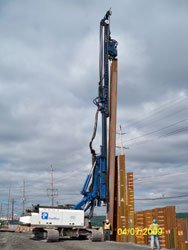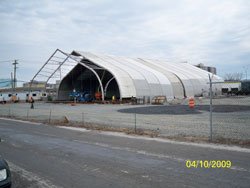
 Continued installation of Waterloo Barrier along north boundary of site |
National Grid’s Remediation Contractor continued with site remediation activities, which included the delivery of construction materials, imported backfill material (clean fill), imported gravel for access road upgrade and expansion, temporary fabric enclosure (tent) structural members and hardware, and additional heavy construction equipment and supplies. Installation of the on-site Waterloo Barrier Wall continued to progress from east to west across the northern part of the site. Record of construction surveys and construction stake-out surveys continued as the site remediation activities progress. The assembly and construction of the Tent Position #1 frame structural members and panels continued at the site. Noise and vibration monitoring activities were conducted during the sheet piling operations of the on-site barrier wall (Waterloo DNAPL Migration Barrier Wall).
Personnel and equipment decontamination pads were utilized throughout the site operations. Further delineation of work zones (i.e., exclusion, decontamination, and support) continued, as required. Upgrade and expansion of the on-site gravel access roads, maintenance of the parking areas and material staging areas, and the imported backfill material (i.e., clean fill) stockpile covers continued. Imported clean fill materials were staged in the central part of the site and utilized as backfill material for the construction of a stabilized working platform for the Waterloo DNAPL Migration Barrier Wall sheet piling rig. Maintenance of engineering controls and soil erosion and sediment control (SESC) measures continued. Odor and dust suppression activities were conducted as necessary. National Grid’s consulting engineer continued to monitor the site activities with the fixed base community air monitoring program (CAMP) equipment.
Photographs of the Waterloo Barrier Wall installation in the northern part of the On-Site Area and temporary fabric enclosure erection at Tent Position # 1 are attached.
 Construction progress on Temporary Fabric Enclosure at the first excavation area |
CAMP data is reviewed and compared to specific NYSDEC/NYSDOH approved criteria, known as “Action Limits.” As a result of this evaluation process, site conditions are categorized into two categories, “Operational Condition” and “Action Condition.” The “Operational Condition” is applicable when the data is below the “Action Limits”, and means that normal operations can continue. The “Action Condition” occurs when one or more of the fifteen minute average measurements for Dust (PM10), Total Volatile Organic Compounds (TVOC), Naphthalene or Odor Intensity are greater than the background or upwind measurement by the specified “Action Limits.” Reaching an Action Level requires corrective action or stopping work until the condition is addressed or abates. During the period from April 6, 2009 through April 12, 2009, sixed base CAMP units and one portable CAMP unit were in-use and measured TVOC and PM10. Fifteen-minute averages for TVOC and PM10 data remained in the Operational Condition. Weekly Reports of the CAMP data can be found as a separate tab in the Weekly Report Archive section.
For the week of April 13, 2009 through April 17, 2009, installation of the on-site Waterloo Barrier Wall will continue from east to west across the northern part of the Site. Work activities associated with the closure of the southern On-Site Area tunnel entrance will continue. Assembly and erection of the tent base frame, structural members, fabric panels, and installation of the vapor management system (VMS) will commence and be completed. After the temporary fabric enclosure is erected and the VMS operational, preparation for shallow excavation activities will commence inside at Tent Position # 1 located in the southeast corner of the site. The on-site gravel access roads and personal and equipment decontamination pads will be further upgraded. National Grid’s consulting engineer will continue to monitor the site activities with noise and vibration monitoring equipment. Odor and dust suppression activities will be conducted as necessary. National Grid’s consulting engineer will continue to monitor the site activities with CAMP equipment.